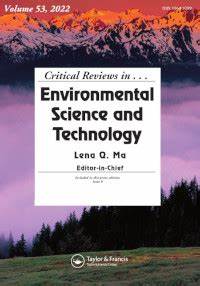Metals in coastal seagrass habitats: A systematic quantitative literature review
IF 11.4
1区 环境科学与生态学
Q1 ENVIRONMENTAL SCIENCES
Critical Reviews in Environmental Science and Technology
Pub Date : 2023-01-09
DOI:10.1080/10643389.2022.2164154
引用次数: 2
Abstract
Abstract Seagrasses provide crucial ecosystem services in the coastal environment, but are under increasing threat associated with anthropogenic activities. Seagrass meadows effectively trap suspended sediment, a key vector for trace metal transport, by altering local hydrodynamic conditions around their leaves and stems. As a result, seagrass meadows often have different geochemical sediment characteristics compared to adjacent bare sediments and may accumulate higher concentrations of trace metals. The aim of this systematic review was to identify research trends and knowledge gaps in the relationships between metals and seagrasses. The systematic search of the literature identified a total of 191 relevant articles. Although seagrasses have a broad geographic distribution, the highest diversity and endemism exists in the Indo-Pacific region, yet most studies (40%) were conducted in the Mediterranean Sea. There were also taxonomic gaps with some common species groups, including Amphibolis and Thalassodendron spp., being poorly studied. The reviewed studies examined the relationship between seagrass and 39 metal elements. There were no studies examining rare-earth elements (REEs) or platinum-group elements (PGEs), both of which are critical classes of metals in emerging technologies. Furthermore, the review determined that all 191 studies focused on the impact of metals on seagrasses, while only six also considered the effect of seagrasses on metal geochemistry in sediments. We conclude that further research is necessary to address these key gaps in knowledge to better understand the role(s) of seagrasses in the distribution, immobilization, and release of trace metals in coastal ecosystems. Graphical abstract沿海海草栖息地中的金属:系统定量文献综述
摘要海草在沿海环境中提供重要的生态系统服务,但与人类活动相关的威胁越来越大。海草草甸通过改变其叶片和茎周围的局部水动力条件,有效地捕获悬浮沉积物,这是微量金属运输的关键载体。因此,与邻近的裸露沉积物相比,海草草甸通常具有不同的地球化学沉积物特征,并可能积累更高浓度的微量金属。这项系统综述的目的是确定金属与海草之间关系的研究趋势和知识差距。通过对文献的系统检索,共发现191篇相关文章。尽管海草的地理分布广泛,但印度洋-太平洋地区的多样性和特有性最高,但大多数研究(40%)都在地中海进行。一些常见物种群也存在分类学上的差距,包括两栖纲和地中海梭属,研究较少。综述的研究考察了海草与39种金属元素之间的关系。没有对稀土元素(REE)或铂族元素(PGE)进行研究,这两种元素都是新兴技术中的关键金属类别。此外,审查确定,所有191项研究都集中在金属对海草的影响上,而只有6项研究也考虑了海草对沉积物中金属地球化学的影响。我们的结论是,有必要进行进一步的研究,以解决这些关键的知识差距,从而更好地了解海草在沿海生态系统中微量金属的分布、固定和释放中的作用。图形摘要
本文章由计算机程序翻译,如有差异,请以英文原文为准。
求助全文
约1分钟内获得全文
求助全文
来源期刊
CiteScore
27.30
自引率
1.60%
发文量
64
审稿时长
2 months
期刊介绍:
Two of the most pressing global challenges of our era involve understanding and addressing the multitude of environmental problems we face. In order to tackle them effectively, it is essential to devise logical strategies and methods for their control. Critical Reviews in Environmental Science and Technology serves as a valuable international platform for the comprehensive assessment of current knowledge across a wide range of environmental science topics.
Environmental science is a field that encompasses the intricate and fluid interactions between various scientific disciplines. These include earth and agricultural sciences, chemistry, biology, medicine, and engineering. Furthermore, new disciplines such as environmental toxicology and risk assessment have emerged in response to the increasing complexity of environmental challenges.
The purpose of Critical Reviews in Environmental Science and Technology is to provide a space for critical analysis and evaluation of existing knowledge in environmental science. By doing so, it encourages the advancement of our understanding and the development of effective solutions. This journal plays a crucial role in fostering international cooperation and collaboration in addressing the pressing environmental issues of our time.

 求助内容:
求助内容: 应助结果提醒方式:
应助结果提醒方式:


